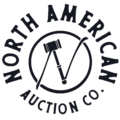For your consideration are nine marked sterling spoons from various makers circa 1870-1910s. The first and largest spoon in this collection was made by S. Hennell in London, England circa 1805-05. The makers mark was present but has since been worn down. The neck of the spoon is long and slim and features stampings on the back of the neck showing the makers mark, a lion passant indicating the quality of the sterling, the town mark of London, a letter "I" indicating the year it was made (1804) and a right facing kings head showing it was made under the rule of King George III. The spoon shows no stamped or embossed designs. The second sterling spoon is attributed to 1852 Redfield & Rice or 1847 Rogers Bros. The spoon features stampings on the back of the neck showing the makers mark, "Y & T" as well as an eagle effigy with its wings spread stamped next to the makers mark. The spoon shows a deep gold washed bowl with small openings for draining any liquid acquired while scooping. The top of the handle shows initials reading "EML". The third spoon in this collection was made by Stebbins & Howe in New York circa 1830-32. By the end of 1829, Edwin Stebbins had relocated from Springfield, Massachusetts to New York City in order to open a jewelry store on Chatham Street. On that same street, he co-owned a business with George Howe from 1831 to 1834, but by 1834 or 1835, he had ended their partnership and had relocated to 264 Broadway. The spoon shows a detailed handle featuring initials reading, "BHR", while the back of the neck shows stampings and the makers mark reading, "Stebbins & Howe". The next spoon in this collection was made in New Orleans circa 1840-50s by Hyde & Goodrich. James N. Hyde spent a few years working in New York before opening a New Orleans location for his retail operation in 1817. Within the following ten years, his brother-in-law Charles Whiting Goodrich joined him in business in New Orleans. By 1828, the first Hyde & Goodrich store was situated on Chartres Street, but in 1853 it was relocated to the intersection of Canal and Royal Streets. However, selling upscale imported goods like patented pistols, pens, watches, and flatware from northeastern and European producers accounted for the majority of Hyde & Goodrich's business. The spoon features a polished coin silver construction with no designs present. The back of the neck shows the makers mark reading, "Hyde & Goodrich". The fifth spoon in this collection is attributed to a silversmith in Holland due to the stamping on the back of the neck. The spoon shows a simple line design on the outer edge of the handle with an "S" on the top of the handle. The back of the neck reads, "Sterling" with the Holland stamp to the left of it. The sixth spoon in this collection was made in Birmingham, England circa 1880-1900s. The spoon features a polished sterling construction with stampings on the back of the neck reading "Sterling" and show a lion passant indicating the quality of the silver, and the town mark of Birmingham. The bowl is large and wide while the neck goes from skinny to wide and flat towards the top. The seventh spoon in this collection once showed a makers mark but has since been stamped out. The spoon is large and features a long handle and large, wide bowl. The top of the handle shows initials reading, "FJ". The back of the neck shows the stamped out makers mark as well as a small, unidentifiable stamp. The eighth spoon in this lot once showed a makers mark but has since been worn off from its age and use over the years. The spoon features a polished sterling construction with no designs present. The ninth and final spoon in this collection was made by Edward Comfort Newbury circa 1840-1860s in Brooklyn, Connecticut. Edward was born August 24th, 1799 in Mansfield Center, Connecticut. He apprenticed around 1814 in Hartford, Connecticut and worked as a silversmith in Brooklyn, Connecticut from 1828 to 1860. He appeared on the 1860 census taken at Brooklyn CT, listed as a spectacle maker, and by the 1870 census he had set aside his trade and was working as a florist. The spoon shows the makers mark on the back of the neck reading, "E. Newbury" while the top of the handle shows initials reading, "CML". The spoons in this collection show good condition overall with some wear and light patinas from their age and use over the years. No obvious signs of damage are present on the spoons. The spoons measure from 11 5/16" L x 2 1/8" W to 7" L x 1 7/16" W. The collective weight of the spoons is 513.4 grams.

























